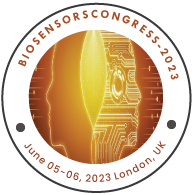Transducers to Biosensors
A Bio transducer is part of the biosensor system recognition and transmission. It consists of two adjacent parts; a layer of biological recognition and a physicochemical transducer, which works together converts chemical signals into electronic or optical signals. Electronic electronics offers more important advantages than physical, chemical and biophysical methods, in terms of high sensitivity and new sensory processes, advanced spatial adjustment, facial integration and regular use of semiconductor processing and label-free, detection real time in place in a non-destructive way. Gravimetric biosensors apply the basic rule of response to weight change. Most gravimetric biosensors use small piezoelectric quartz crystals, either as crystalline crystals (QCM), or as bulk / surface acoustic wave (SAW) devices. Pyroelectric biosensors generate electrical energy due to temperature changes. This difference creates a separation in the object, producing a dipole moment at which the gradient of the temperature is referred to. The result is a net voltage across all equipment.
Related Conference of Transducers to Biosensors
Transducers to Biosensors Conference Speakers
Recommended Sessions
- Advancement in Nanotechnology
- Applications for Biosensors
- Bio MEMS/NEMS
- Bio sensing Technology
- Bioelectronics
- Bioinstrumentation
- Biosensors
- Biosensors for Imaging
- DNA Chips and Nucleic Acid Sensors
- DNA Chips and Nucleic Acid Sensors
- Environmental Biosensors
- Enzyme-Based Biosensors
- Gas Sensors
- Nanobioelectronics
- Nanomaterials & Nanoanalytical systems
- Photonic Sensor Technologies
- Photonic Sensor Technologies
- Security and Sensing
- Transducers to Biosensors
Related Journals
Are you interested in
- 3D Structure Determination - Structural Biology-2026 (France)
- Advanced Techniques in Structural Biology - Structural Biology-2026 (France)
- AI & Computational Structural Biology - Structural Biology-2026 (France)
- Biochemistry and Biophysics - Structural Biology-2026 (France)
- Computational Approach in Structural Biology - Structural Biology-2026 (France)
- Drug Designing and Biomarkers - Structural Biology-2026 (France)
- Hybrid Approaches for Structure Prediction - Structural Biology-2026 (France)
- Membrane Proteins and Receptors - Structural Biology-2026 (France)
- Molecular Modelling and Dynamics - Structural Biology-2026 (France)
- Proteomics and Genomics - Structural Biology-2026 (France)
- Structural Bioinformatics and Computational Biology - Structural Biology-2026 (France)
- Structural Biology in Cancer Research - Structural Biology-2026 (France)
- Structural Virology - Structural Biology-2026 (France)
- Structural Virology and Infectious Diseases - Structural Biology-2026 (France)
- Structure-Based Drug Discovery - Structural Biology-2026 (France)
- Structure-Based Solutions to Global Health Challenges - Structural Biology-2026 (France)
- Structure-Function Relationships - Structural Biology-2026 (France)
- The Structural Basis of Disease - Structural Biology-2026 (France)

